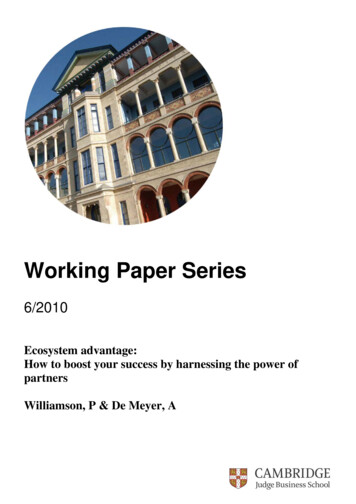
Transcription
Working Paper Series6/2010Ecosystem advantage:How to boost your success by harnessing the power ofpartnersWilliamson, P & De Meyer, A
These papers are produced by Cambridge Judge Business School, University ofCambridge. They are circulated for discussion purposes only. Their contents shouldbe considered preliminary and are not to be quoted without the authors’ permission.Cambridge Judge Business School author contact details are as follows:Peter WilliamsonCambridge Judge Business SchoolUniversity of Cambridgep.williamson@jbs.cam.ac.ukPlease address enquiries about the series to:Research ManagerCambridge Judge Business SchoolTrumpington StreetCambridge CB2 1AG, UKTel: 01223 760546 Fax: 01223 339701Email: research-support@jbs.cam.ac.uk
AbstractBased on the observation of best practice and detailed case studies we observe thatcompanies have started to organise themselves in loosely coupled networks, similar to themediaeval ‘commons’, and which we call ecosystems. These are far less structured than jointventures, but have at the same time a lower level of transaction costs than pure marketsystems. These ecosystems seem to be better adapted to respond to the demand for complex,integrated solutions, rather than standardised products and services delivered in homogeneousvolume.The imperative for gaining competitive advantage via these ecosystems is for firms to createsustainable ecosystems and for the lead firm how to capture the value created by theecosystem. Based on a set of case studies we develop six keys to create the ecosystemadvantage: the clarity about the creation of value added, the definition and structuring of thepartner roles, how to stimulate complementary partner investments, the need to reduce thetransaction costs, how to stimulate co-learning in the network and how to engineer effectivevalue capture mechanisms.Key words: ecosystem, value capturing, networks
The idea that a company’s own success partly depends on the performance of itssurrounding ecosystem – the network of firms, institutions and individuals with which itinteracts – is by no means new. Studies of the woollen textile ecosystem in 14th CenturyPrato, Italy, estimated to involve some 24,000 people, for example, have shown how specificcompanies both contributed to and leveraged upon the mutual strength of their networki.Recreating a similar network many centuries later propelled the clothing company, Benetton,into the global market.In other cases, such as the early battle in personal computers (PCs) between the“IBM-compatible” ecosystem of hardware, software and services suppliers and Apple’s muchmore independent, integrated value chain, the ecosystem approach won out. But the lead firm(in this case IBM) struggled to achieve sustainable profitability in the business. Building athriving ecosystem around you, therefore, seems far from sufficient to guarantee success.Equally critical, experience suggests, is finding the right way to engender, structure andmanage your company’s relationships within its ecosystem in order to harness its potential toimprove your own performance. To build ecosystem advantage requires the creation of anetwork of relationships, interfaces and processes that can deliver value to the end customermore efficiently by connecting potentially complementary participants to each other, managetechnological and market uncertainty among partners with different businesses models andwho face different risks, and a way to capture a healthy share of the value created for yourown company. The emergence of an ecosystem can be promoted by the actions of a “leadfirm” – a company that controls one or more of the key ingredients of the value-generatingactivities required to deliver a product or service and the vision and capabilities to win thecooperation of other potential players. But building ecosystem advantage demands the leadfirm to go far beyond “open innovation” to create a new form of economic organisation thattranscends the traditional notions of industries, markets and hierarchies that have dominatedcorporate thinking for the last hundred years.Learning to do these things well is becoming a high-stakes imperative. Witness therecent struggle between Sony’s Blu-ray versus Toshiba’s HDDV technologies in the quest fordominance in the market for next-generation consumer electronics. Today’s battle betweenNokia, Apple, Microsoft and new entrant Google in the market for smartphones is a clash ofalternative ecosystems. At one end of the activity chain, Nokia has put together a network ofpartnerships to position the Symbian operating system in its defence against Microsoft’s
attempt to put its software at the centre of tomorrow’s mobile communications. Nokia’smoves to add user-focused services such as email, maps and its Comes With Music offeringrely on bringing together an extensive network of specialist partners. Apple, meanwhile, hasstimulated an army of developers, from Electronic Arts (one of the world’s largest producersof electronic games) through to individuals working in the garage, to create over 100,000applications that sun on its iPhone. Google has built leveraged an ecosystem dubbed OpenHandset Alliance involving a group of 47 technology and mobile companies to rapidlyestablish its Android operating system in the market for mobile devices. Google claims thisecosystem allows it to “accelerate innovation in mobile and offer consumers a richer, lessexpensive, and better mobile experience.”ii In just over a year its software partners havecreated over 20,000 applications on the Android platform.Likewise, IBM, Oracle and SAP, meanwhile, now talk about the strength of thebusiness ecosystems as a decisive factor in competition for tomorrow’s distributed world ofso called “cloud computing” where software will increasingly be sold as a service, rather thana product.In this article we begin by examining why capabilities in building and managing yourbusiness ecosystem will become increasingly important to securing competitive advantage inthe future. We then go on to propose six key requirements for successfully leveragingpotential ecosystem advantage. We conclude with the implications for corporate strategies.The Growing Importance of Your Business EcosystemThere are four reasons to believe that ecosystem relationships will becomeincreasingly important in determining future competitive success. First, in the face of risinginvestment demands and increased costs of complexity, many companies are seeking to focuson fewer core activities. This enables them to target their capital expenditure on deployingthe latest technology on their core processes and to concentrate on deepening their corecompetenciesiii. The adage “focus and win” has become a popular catch phrase. But shrinkingto a focused core of activities is at odds with customers who are increasingly demandingmore complete solutions to their needs that bring together multiple products and services incomplex, often customised, bundles. One answer to “shrinking core, expanding periphery”problem is to outsource more to partnersiv. But it is impossible to deliver a complex solutionbundle involving multiple technologies, capabilities, and services using the kind ofsubcontracting relationships familiar in traditional supply chains. Rather than outsourcing afew well-defined activities, delivering complex customer solutions requires the management
of complicated interactions and exchange of knowledge between many, co-dependentpartnersv.A good example is the so-called “smart grid” – an electricity distribution grid that hasbeen upgraded to incorporate information sensors, digital meters and a communicationsnetwork that can avoid outages, optimise energy allocation, and incorporate fluctuations inthe supply from green technologies such as wind, wave and solar power generation. IBMaspires to be one of the lead companies in this arena with its “Smarter Planet Initiative”. Butto accomplish the necessary combination of technologies, capabilities and infrastructurenecessary to deliver the smart grid, IBM recognises that it “needs friends – lots of them”interacting intensively and in ever-changing configurations. So it kicked off the initiativewith eight charter members including a group of power utilities along with Johnson Controls,Honeywell Building Solutions, Cisco and Siemens. The goal goes far beyond researchcollaboration. Instead IBM seeks to launch a new business model that integrates theirtechnologies with a complex set of products and services from the ecosystem partners dubbed“The Green Sigma Solution”vi.Increasingly, therefore, shrinking the core and expanding the periphery calls for thecapabilities to create and manage efficiently an extensive and complex business ecosystem.Second, the rising knowledge content of many business activities and increasingnumber of “knowledge workers” in most industries means that fewer of the interactionsbetween businesses in the activity chain involve simple, standardised physical interfaces.Instead more complex knowledge needs to flow between partners, grey boundaries ofresponsibility need to be managed, as does the claim to intellectual property generated in thecourse of business. Consider the example of the French software company Dassault Systemes(DS). They are leading specialists in providing solutions for Product Life Cycle Management.Whereas the basic principles of modelling and design of products and processes may becommon to many industries, effective software solutions need to incorporate in-depthknowledge of an industry. To access this knowledge DS collaborates with hundreds ofpartners, including system integrators, customers and suppliers. Many of these developmentpartners are granted managed access to the internal DS social network. It is this ecosystem ofpartners that enables DS to be relevant and successful in 11 different industries and togradually increase its market share in PLM systems. This suggests that as knowledgemanagement becomes increasingly central to competitive success, the capabilities to build
and manage an extensive ecosystem with the right set of relationships between partners willbe critical.Third, technologies subject to increasing returns – such as the “network benefits” toany individual customer of widespread adoption of everything from software to mobiledevices – are arguably playing an ever-larger role in many industriesvii. The strength andreach of a company’s ecosystem is an important determinant of its ability to benefit from thepotential for increasing returns.This may be even more important when technologies with considerable networkeffects are still in development and confronted with a high level of uncertainty. Additionaluncertainty can often be better absorbed in an eco-system where the partners can co-developand co-experiment compared with a traditional hierarchy or subcontracting relationshipwhere deliverables have to be precisely specified in advance. The diversity in the eco-systemmay also offer access to additional creativity in the creation of solutions.Fourth, advanced information and communications technologies (ITC) are enablingbusiness ecosystems that marshal diverse, and increasingly global, resources to create valueto become cost effective. In the past, potentially valuable networking between diverse anddispersed partners was often thwarted by the prohibitive costs of ITC required to facilitateongoing interaction and knowledge exchange. The technological advances and falling unitcost of remote communication, while it will not be a complete substitute in the near future forface-to-face interaction, is enabling ever more complex and dispersed ecosystems to becomeeconomically viable. Take the example of the animation studio Wild Brain. It usesindependent writers based in Florida, London, New York, Chicago and Los Angeles. Theanimation of the characters is done by specialist companies in Bangalore with edits in SanFrancisco. A single film involves eight teams in Bangalore matched to eight counterpartwriters working in parallel using a virtual private network that allows every participants toshare feeds of sound and images from the recording sessions, real-time script and all theanimation designs from every location simultaneouslyviii. ITC is dramatically narrowing theefficiency gap between traditional corporate hierarchy and an ecosystem comprised ofdiverse and dispersed partners.Prominent among the many impacts of these forces has been the adoption of “openinnovation” strategies by many companies. Open innovation is the idea that: “firms can andshould use external ideas as well as internal ideas, and internal and external paths to market,as the firms look to advance their technology”ix But this is only one aspect of building
ecosystem advantage. Creating a business ecosystem involves re-configuring the entireactivity chain to harness the capabilities of complementary partners in ways that create morevalue for the end customer. This typically involves designing a broad-based multi-companynetwork that brings together different product and services to create a more complete solutionfor customers, stimulating complementary investments by partners in everything fromproduction capacity delivery and distribution infrastructure, market making, tools andtraining, and after-sales service, as well as R&D and innovation.Despite the potential benefits of reconfiguring your company’s value chain to harnessthe power of a business ecosystem, we should not lose sight of the very real benefitsdelivered by the alternative of the traditional organisational hierarchy: a structure thatinternalises the linkages between different activities and specialist competences inside thefirm. These include the advantages of lower transaction costs, the ability to maximisealignment between different specialist activities and players and optimise the interface, and toreduce risk and uncertainty through direct controlx. The success of Intel’s verticallyintegrated business model or the closed and tightly controlled way in which Apple designsand develops its core hardware platforms (such as the iPod, MacBook or iPad) are importantreminders that building an ecosystem is not always the optimal strategy. Other things equal,business ecosystems usually impose a cost penalty over traditional organisational forms. Andas we have seen in the case IBM-compatible architecture in PCs, strategies based onecosystems expose the lead company to the risk that most of the profits will leak away topartners. The critical question, therefore, is: How can a company shape the structure andworkings of its business ecosystem to simultaneously create and capture value, whileminimising the detrimental effects of surrendering hierarchy, vertical integration and directcontrol?Six Keys to Ecosystem AdvantageBusiness ecosystems differ markedly in their scope, structures, and the nature of therelationships and processes on which they depend. But by examining many ecosystems andtheir impacts on the ongoing success of the lead companies at their core, we have discerned aset of common patterns.Companies that are successful in leveraging the potential of ecosystem advantagebegin with a change in mindset. “Not invented here” prejudices need to be jettisoned. Theystart from the premise that knowledge is abundant and widely distributed both internally withtheir organisation and in the external world so the task is to harness this potential. They
understand that intellectual property (IP) gains value when it is connected to thecomplementary IP and knowledge of many others so as to unleash the power of networkeconomies, not by locking it away in an impenetrable safe. And that the ultimate keyperformance measure (KPI) is the value you create for the customer – whether directly jointlythrough others, not the volume of activity, the number of people or the accumulation ofinternal assets you control.Once a company’s senior management has adopted this perspective, the task is to turnthese insights into a profitable business model. We have distilled six keys required to unlockthis new type of ecosystem advantage.1.Creating Added ValueMuch of the discussion around business ecosystems focuses on how value is sharedbetween the various parties involved. Certainly it is an important principle that participationhas to be attractive to those involved, if a thriving ecosystem is to be sustained. But it isequally critical to remember that all the costs and profits within the ecosystem have to becovered by the ultimate customers for the network’s products and services. Customers’willingness to pay depends on recognition of incremental value from the ecosystem over andabove that offered by an alternative, vertically integrated supplier.This incremental value can be created in many different ways. Take the case of ARMHoldings Plc, a major supplier of intellectual property to the semi-conductor industry. ARMis a pivotal player in the ecosystem of Reduced Instruction Set Computing (RISC) chips, Itsdesigns, for example, power 98% of the world’s mobile telephone handsets. By being part ofARM’s ecosystem, handset makers such as Nokia or Samsung can share the costs ofdeveloping a flexible platform on which to build their devices across virtually the entireindustry, enabling them to concentrate their resources on developing their own proprietarytechnologies on top of ARM’s base to make their products such as a mobile phone to be moreattractive to their customers. Being part of the ecosystem also allows handset makers tochoose from a wide range of semiconductor manufacturers who use the same standarddesigns, rather than being locked into proprietary technology. And it improves their chancesof finding supply when an upswing in the semiconductor cycle led to shortage. As a result,end customers benefit from improved reliability, lower costs and faster access totechnological advances. ARM summarises its strategy as follows: “create a partnership withour customers and broader community of third parties, to enable the creation of end products
more efficiently through ARM than from any other source”. Google’s Open HandsetAlliance, meanwhile, brings together 47 technology and mobile telephony companiesworking with the “Android” operating system to: “Offer consumers a richer, less expensive,and better mobile experience by accelerating innovation”.The first step toward nurturing a successful business ecosystem, therefore, is topinpoint exactly why it will create extra value for the end customer who ultimately pays thebill.2.Structuring Differentiated Partner RolesAn ecosystem has the potential to create additional value for end customers because itbrings together a set of differentiated partners with complementary capabilities and differenteconomies. Realising the potential of an ecosystem, therefore, requires the lead firm to createa structure and the incentives necessary to align partners with different roles and to managethe overlaps and possible conflicts between them. Apart from being the lead firm in theecosystem any partner can play at least one of six roles within it. These include traditionalsupply chains roles of providing components of a solution, operational capacity, saleschannels, or complementary products and services. But partners in an ecosystem can also actas an important source of technology and competence or market and customer knowledge forthe lead firm. Whenever ARM grants a license to use its technology, for example, it developsa reciprocal relationship with the licensee. The aim of this relationship is to gain insights intothe licensee’s process technology roadmaps and access to emerging applications, becoming atwo-way partnership. Under this arrangement, ARM’s partners thus not only boost ARM’ssales, they also provide market knowledge and insights that would help ARM to design chipsbetter suited to future market and application needs and to developments in chip fabricationand design technologies.Partners can also act as “market makers” for the ecosystem. Their operations orreputations may help gain acceptance of a product or technology in the market and thisstimulate additional demand. In pursuing sales of their own products and services they may“pull through” demand for the complimentary offerings of the ecosystem. Likewise bytraining users of their own products they may generate demand for compatible productsoffered by the ecosystem among those who see an advantage in leveraging their investmentin new skills.
Ideally the lead firm should aim to promote an ecosystem that combines a set ofspecialist niches, each of which makes a different contribution to value creation and thatcreate a positive spiral by generating new knowledge or additional demand as they interact.One or more partners may profitably inhabit each niche – which itself may be large in termsof volume and revenues. In the case of ARM’s ecosystem, for example, wafer fabricationforms such a specialist activity, as does the creation of electronic design automation tools.Both are inhabited by tens of partners. Competition within each niche may generate benefitsfor the ecosystem by encouraging rivals to improve efficiency or drive innovation in thatactivity. Overlaps between the way in which each niche contributes to the overall value theecosystem delivers to the end customer, by contrast, are likely to be detrimental to theecosystem’s performance. This is because if the niches, and hence the tasks, overlap theinterfaces between the elements will become blurred. Duplication, uncertainty and confusionwill result. The lead firm’s aim, therefore, is to assist the emergence of a structure where eachbundle of value-creating activities is clearly delineated from the next, so as to form a neatjigsaw of niches. Each of these niches would be “plug-compatible” with the others so thatcustomers could choose to reconfigure the particular set of delivery partners in accordancewith their specific needs without disrupting the ability of the ecosystem to seamlessly deliverits end product.As we will see below, lead firms need to be able to manage the process of co-learningin ways that maintain the delineation and compatibility between the different niches as theecosystem evolves.The set of niches comprising the ecosystem also needs to be complete – in the sensethat all of the necessary tasks required to deliver the value proposition to the end customerneed to be covered. This may seem obvious, but important gaps can sometimes beoverlooked. In businesses characterised by “network effects” – where the user benefits onlywhen a critical mass of others adopt the same technology, for example – market making willbe an essential ingredient for value creation even though it is not technically required todeliver the product or service. To ensure these gaps are filled both at the outset and thecontribution of different niches is maintained, the lead firm therefore needs to find ways ofstimulating the partners to make complementary investments to underpin the ecosystem. Bystimulating co-investment by partners a lead firm can also create a multiplier effect, enablingexponential growth in the ecosystem for each incremental investment of its own resources.
3.Stimulating Complementary Partner InvestmentsA prerequisite for co-investment by partners, of course, is the prospect of building aprofitable business. The lead firm therefore needs to consider how it can create valuepropositions for potential partners as well as end customersxi. Google Maps is a successfulexample. Their proposition to partners is that: “Google Maps and associated infrastructureacts as an innovation hub where potential partners can create new applications thatincorporate elements of Google functionality. Partners can easily test and launch applicationsand have them hosted in Google World that has 150 million customers globally.”If the partner value proposition is weak, or the niches created turn out to bechronically unprofitable, the ecosystem will be unable to solicit the necessary partnerinvestment to underpin stable growth. Likewise if the lead firm routinely encroaches onprofitable partner niches by seeking to bring them in-house, partners’ willingness to investwill be undermined. In some cases, the evolution of technology may demand that the leadfirm incorporate a niche into its in-house activities so as to improve the value delivered toend users. Such was the case, for example, when Intel incorporated wireless capabilities thatwere formerly provided by partner firms that supplied the PCIMA cards into its Centrino chipto improve the performance and convenience of wireless applications. In a healthyecosystem, however, this should be a rare event. Even then, it is preferable if the lead firm isable to open up new niches that existing partners might migrate into in order to maintain thewillingness of current and future potential partners to invest in the ecosystem.More broadly, high levels of uncertainty will dissuade partners from investing.Coping with uncertainty in an eco-system is hard because of the diversity in the partners’objectives and culture. This diversity increases the risk that individual partner investmentdecisions follow divergent, or even conflicting, paths. It also means it is difficult forindividual partners to understand the causality of what is happening in the eco-system. Thisincreases the risk of a breakdown of “sense-making”, so that even well intentionedinvestments in the ecosystem may prove useless, or even destructive. To promote the ongoingsuccess of an ecosystem, therefore, the lead firmmust act to reduce this uncertaintydramatically by providing a clear roadmap of the future technology platform on which theecosystem is built.In a fast-moving industry with rapidly changing technology or customer needs andbehaviour we argued that it is also critical that the “roadmap” for the future development of
the ecosystem is made transparent to participants (some of whom, as in “open source”activities, may not even be known to the nodal firm). Such a roadmap has an important rolein reducing uncertainty and promoting convergence of efforts towards the effectivedevelopment of a coherent set of ecosystem offerings. Without it, the ecosystem risksbecoming divergent. This would undermine the ability and willingness of participants tomake long-term investments necessary for the future prosperity of the ecosystem. At thesame time, the roadmap’s prescriptions need to be sufficiently broad to allow for theecosystem to adapt to changing circumstances – a requirement that leads to our final key toecosystem advantage: building in flexibility.A shared roadmap for innovation, even if it is not very detailed, will enable thepartners in the network to make sense out of unforeseen events and enable them to keep onmaking investments that strengthen the ecosystem. The case of the Nano, the low cost cardeveloped by the Indian industrial giant Tata is a good example of the role such a roadmapneeds to play. Ratan Tata, the chairman of Tata Motors, initiated the development of theNano as the world’s cheapest car in 2003. Contrary to speculation that it may have become afour-wheeled rickshaw, it was developed against all odds and industry wisdom as a welldesigned car that could be manufactured efficiently using modern technologies. In order toachieve this Tata constantly sought new design approaches from its international suppliernetwork. The car was designed in Italy, and many components were made by majorautomotive suppliers such as Bosch, ContinentalAG, Delphi, GKN, St. Gobain and manyothers. Many of them had to push the technological limits in order to design a low costcomponent. The mere fact that the Nano’s development was a success was to a large extentdue to the clarity of Ratan Tata’s vision and ambition, which acted as a roadmap to guide thenetwork of suppliers as they pushed the boundaries of accepted designs and technologies.Depending on the industry and technology, however, the roadmap communicated bythe lead firm may need to be more specific. In May 2008, for example, enterprise applicationsoftware provider, SAP, unveiled a roadmap for enabling its customer relationshipmanagement (CRM) software to interface with mobile devices and so called “Web 2.0”applications. This roadmap provided ecosystem partners such as Research In Motion (RIM),the Canadian wireless communications provider behind the development of BlackBerrymobile devices, and smaller software companies developing software to work with Apple’siPhone both the information protocols and the certainty they needed to make investments in
providing mobile services to sales people whose companies use SAP’s CRM software as partof their core IT infrastructure.ARM, meanwhile, hosted an annual ARM Partner Meeting annually over three daysin Cambridge. Although the criteria for inviting partners had varied over the years, inviteesincluded the OEMs and providers of complementary products and software as well as ARM’sdirect customers. At this event, ARM’s current roadmap was presented and discussed with awide range of partners.Once the lead firm has established appropriate conditions to stimulate investments byecosystem partners that are aligned in ways that promote the overall success of the ecosystemin creating value as well as benefitting the individual partner, it must also concern itself withenabling the interactions between partners to operate as efficiently as possible by findingways to reduce ongoing transactions costs.4.Reducing Transactions CostsOne of the inherent disadvantages faced by an ecosystem relative to a single,vertically integrated organisation is the high transactions costs that result from having amultitude of relationships, some of them loose and incompletely defined and regulated. Ifthese are not controlled they can rapidly come to outweigh the extra custo
Cambridge Judge Business School author contact details are as follows: Peter Williamson Cambridge Judge Business School University of Cambridge p.williamson@jbs.cam.ac.uk Please address enquiries about the series to: Research Manager Cambridge Judge Business School Trumpington Street Cambridge CB2 1AG, UK Tel: 01223 760546 Fax: 01223 339701










